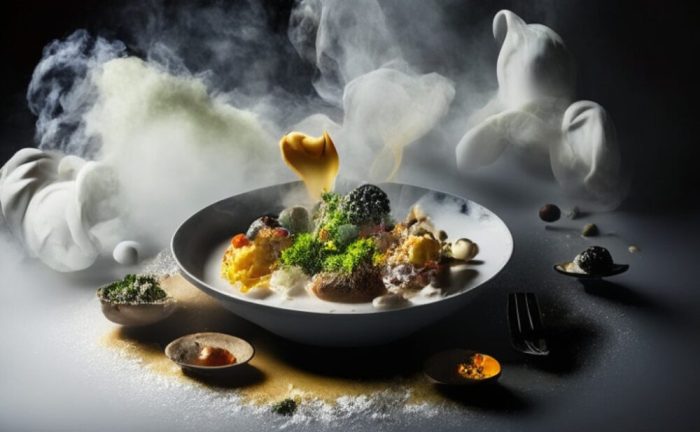Transforming everyday dishes into culinary delights is an art form that elevates the ordinary into the extraordinary. By employing innovative culinary techniques, exploring unique ingredients, and creating harmonious flavor profiles, home cooks can transform their meals into unforgettable dining experiences. This comprehensive guide provides a roadmap for aspiring culinary enthusiasts, empowering them to unlock the secrets of creating restaurant-quality dishes in the comfort of their own kitchens.
Within this guide, readers will embark on a culinary journey that covers a wide range of topics, including enhancing culinary techniques, exploring ingredient substitutions, crafting creative flavor profiles, and mastering the art of culinary presentation. With clear instructions, practical examples, and inspiring recipes, this guide empowers home cooks to elevate their cooking skills and create dishes that tantalize the taste buds and impress their guests.
Enhancing Culinary Techniques
In the realm of gastronomy, culinary techniques play a pivotal role in elevating ordinary dishes to culinary masterpieces. Various methods and approaches can be employed to transform ingredients, enhance flavors, and create visually stunning presentations.
One such technique is sous vide, a method of cooking food in vacuum-sealed bags submerged in a precisely controlled water bath. This technique allows for consistent and even cooking, resulting in tender and flavorful dishes. Molecular gastronomy, another innovative approach, utilizes scientific principles and techniques to create novel culinary experiences, such as spherification and foams.
Plating Techniques
Plating techniques are essential for showcasing culinary creations in an aesthetically pleasing manner. Proper plating can enhance the visual appeal of a dish, stimulate the appetite, and influence the overall dining experience.
- Composition: The arrangement of elements on the plate, considering balance, color contrast, and negative space.
- Garnishing: Using herbs, sauces, or edible flowers to add visual interest and enhance flavors.
- Height: Creating dimension and visual appeal by stacking or layering ingredients.
- Color Theory: Utilizing color combinations to create visually appealing and harmonious dishes.
Culinary education and training play a crucial role in developing the skills and knowledge necessary for enhancing culinary techniques. Through hands-on experience, chefs learn to master various techniques, experiment with ingredients, and refine their presentation skills.
Ingredient Exploration and Substitution
Unlocking the potential of everyday dishes requires a discerning palate and an adventurous spirit. By exploring unique and flavorful ingredients, culinary enthusiasts can transform ordinary meals into extraordinary culinary delights. Moreover, ingredient substitution empowers home cooks to create new flavor combinations and accommodate dietary restrictions, unlocking a world of culinary possibilities.
Unique and Flavorful Ingredients, Transforming everyday dishes into culinary delights
The culinary landscape is brimming with ingredients that possess the power to elevate dishes to new heights. Consider the vibrant hues and zesty flavors of harissa, a North African chili paste that adds a fiery kick to stews, soups, and grilled meats. Miso, a fermented soybean paste from Japan, imparts a rich umami flavor to soups, marinades, and dressings. Sumac, a tangy spice made from dried sumac berries, adds a bright acidity to grilled vegetables, salads, and meat rubs.
Transforming everyday dishes into culinary delights is a creative and rewarding endeavor. Culinary adventures from home offer a plethora of opportunities to experiment with flavors and techniques, turning ordinary meals into extraordinary culinary experiences. By embracing the joy of cooking and experimenting with different ingredients, home cooks can elevate their everyday dishes to new heights of taste and presentation, transforming them into delectable creations that will delight both the palate and the senses.
Ingredient Substitution
Ingredient substitution is an art that allows cooks to adapt recipes to their preferences, dietary needs, and available ingredients. By understanding the flavor profiles and textures of different ingredients, it is possible to create successful swaps that enhance taste and nutritional value. For instance, replacing all-purpose flour with almond flour in baked goods creates a gluten-free alternative with a nutty flavor. Substituting white sugar with coconut sugar provides a lower glycemic index and a hint of caramel sweetness. Using plant-based milk instead of dairy milk in soups and sauces offers a creamy texture and reduces saturated fat intake.
Creative Flavor Profiles

Creating harmonious flavor profiles is an art that involves blending different flavors to achieve a desired effect. Understanding the principles of balancing sweet, sour, salty, bitter, and umami flavors is essential in this process.
The balance of these flavors can evoke specific emotions or culinary experiences. For example, a sweet and sour combination can create a sense of freshness and excitement, while a salty and bitter combination can evoke a sense of depth and complexity.
Transforming everyday dishes into culinary delights requires not only creativity but also a mastery of cooking techniques. By Mastering cooking techniques at home , home cooks can elevate ordinary ingredients into extraordinary dishes. With the right techniques, such as searing, roasting, and braising, even the simplest dishes can be transformed into culinary masterpieces.
The Art of Blending Flavors
- Consider the flavor profile of each ingredient.
- Experiment with different combinations to find what works best.
- Use herbs, spices, and other seasonings to enhance flavors.
Principles of Balancing Flavors
The five basic tastes—sweet, sour, salty, bitter, and umami—play a crucial role in creating harmonious flavor profiles.
- Sweet flavors provide a sense of richness and fullness.
- Sour flavors add brightness and acidity.
- Salty flavors enhance other flavors and add depth.
- Bitter flavors provide complexity and balance.
- Umami flavors add a savory, meaty taste.
Flavor Combinations for Specific Effects
- Sweet and sour: Lemon and sugar in lemonade.
- Salty and bitter: Dark chocolate with sea salt.
- Umami and sweet: Soy sauce and honey in teriyaki sauce.
Kitchen Recipes and Inspiration
The kitchen is the heart of any home, and a well-stocked kitchen is a joy to cook in. With the right recipes and inspiration, you can create delicious meals that will impress your family and friends.
Recipe Presentation
To make your recipes easy to follow, use a clear and concise table layout. Include columns for ingredients, quantities, cooking methods, and estimated preparation time. This will help you stay organized and ensure that you have all the necessary information at your fingertips.
Here is an example of a recipe table:
| Ingredient | Quantity | Cooking Method | Preparation Time |
|---|---|---|---|
| Chicken breasts | 4 | Grilled | 30 minutes |
| Potatoes | 1 pound | Roasted | 45 minutes |
| Carrots | 1 pound | Sautéed | 20 minutes |
| Green beans | 1 pound | Steamed | 15 minutes |
Culinary Inspiration
In addition to providing recipes, it is also important to provide culinary inspiration. This can come in the form of innovative recipes, cooking techniques, or even just ideas for how to use your ingredients in new and exciting ways.
Here are a few examples of culinary inspiration:
- A recipe for a new and exciting dish that you have never tried before.
- A cooking technique that you have never used before, such as sous vide or smoking.
- An idea for how to use your ingredients in a new and exciting way, such as using leftover chicken to make a soup or salad.
Culinary Presentation and Aesthetics
The presentation of a dish plays a pivotal role in elevating the dining experience, transforming ordinary meals into culinary delights. By arranging dishes aesthetically, chefs can stimulate diners’ senses and create a memorable dining occasion.
To achieve an aesthetically pleasing presentation, chefs employ various techniques, including color contrast, texture variation, and composition arrangement. By contrasting vibrant colors, such as green asparagus with red tomatoes, dishes become visually appealing and stimulate the appetite. Additionally, incorporating different textures, such as crispy tempura with soft and creamy avocado, adds visual interest and enhances the overall dining experience.
Composition Arrangement
The arrangement of elements on a plate is crucial for creating a visually appealing dish. Chefs consider the balance, proportion, and focal point of the plate to create a harmonious composition. Dishes should be balanced in terms of weight and distribution, ensuring that heavier elements are placed near the center and lighter elements towards the edges. Proper proportion involves using appropriate-sized plates and ensuring that the main elements are not overwhelmed by the supporting elements. Finally, the focal point of the dish, such as a vibrant sauce or a centerpiece ingredient, should be placed strategically to draw the diner’s attention.
Conclusive Thoughts: Transforming Everyday Dishes Into Culinary Delights

Transforming everyday dishes into culinary delights is not merely about following recipes; it is about embracing creativity, experimentation, and a passion for food. By mastering the techniques and principles Artikeld in this guide, home cooks can unlock their culinary potential and create dishes that not only satisfy their hunger but also delight their senses and create lasting memories around the dinner table.
Helpful Answers
What are the key culinary techniques for transforming everyday dishes?
Sous vide, molecular gastronomy, and plating techniques are essential culinary techniques that can elevate ordinary dishes. Sous vide allows for precise temperature control, resulting in tender and flavorful meats and vegetables. Molecular gastronomy introduces innovative ingredients and techniques to create unique textures and flavors. Plating techniques enhance the visual appeal of dishes, making them more appetizing and memorable.
How can I explore unique ingredients to enhance my dishes?
Explore local farmers’ markets, specialty food stores, and online retailers to discover unique and flavorful ingredients. Experiment with different cuisines and cultures to find ingredients that add depth and complexity to your dishes. Consider using seasonal ingredients to ensure freshness and support local farmers.
What are the principles of creating harmonious flavor profiles?
Balancing sweet, sour, salty, bitter, and umami flavors is crucial for creating harmonious flavor profiles. Experiment with different combinations of ingredients to find the right balance for your palate. Consider the purpose of the dish and the desired taste experience when crafting flavor profiles.


